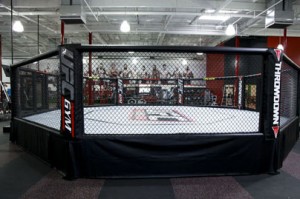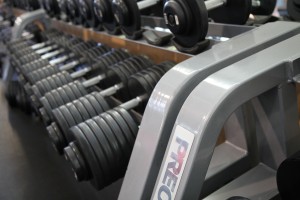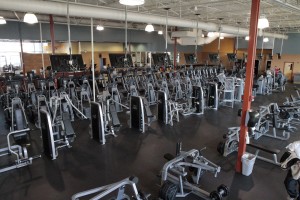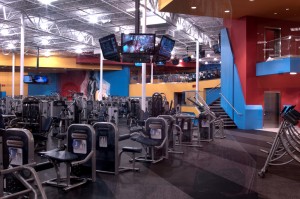
When some members step into a club, the words “strength training” bring to mind images of grunting muscle men with huge biceps, bulging veins and overly tanned skin. According to Josh Harwood, the senior vice president of operations for Fitness Connection, it’s your job as a club owner to teach them otherwise — that strength training isn’t just for bodybuilders, but instead is an essential part of every members’ fitness routine.
“[Strength training] is a hundred percent necessary to do,” said Hardwood. “The benefits of strength training — regulating calcium, improving the condition of your muscle and blood flow, helping to keep your ideal body weight, fighting off injury because your joints are well supported,” are all results of increased muscle mass. “It is absolutely imperative to have strength training. Cardio is just not enough … to get in peak condition,” he explained.
According to Mike Feeney, the vice president of New Evolution Ventures (NeV), many Americans aren’t reaping the benefits from strength training. Feeney places the majority of people into a group he calls the “85 Percenters.” Consisting of the average person who doesn’t typically work out, said Feeney — what that 85 percent don’t know, are the positive results they’ll experience from strength training for 15-20 minutes, at least three times a week. Those results include experiencing a stronger, fitter and leaner physique — which in turn leads to a boost in energy levels and overall self-confidence. “If you can get [people] off the couch and into any fitness center — the improvements they’re going to get with increased muscle mass is really going to blow their minds,” said Feeney.
That is why you, as a club owner, need to educate members on the benefits they’ll experience — and make strength training as accessible and non-intimidating to members as possible.

The first step to making strength training less intimidating as possible for members lies in the placement and design of the strength training area.
Scott Lewandowski, the regional director for Fitness Formula, avoids segmenting the strength training and cardio areas altogether. “We keep spaces open so as not to create a separate room that can be intimidating,” he said. To designate the different areas, instead of walls, Fitness Formula separates the advanced strength training areas and cardio equipment with different flooring. “[This] allows members on cardio equipment to view what is happening in the strength area and witness for themselves that strength training is for all individuals,” said Lewandowski. By integrating the cardio and strength training areas, members can easily “conduct circuit training, alternating short bouts of cardio training and strength training, to increase fat burning potential,” Lewandowski explained.
However, whether or not you completely separate the cardio and strength training areas is up to you, but what to keep in mind is that “instruction and location are key,” to making members feel comfortable, said Harwood. “It starts with the selection of your equipment and providing instruction. Are you putting it in an area of the facility [the members] are going to be comfortable using it in?” asked Harwood.
By putting yourself in the perspective of the member, you can analyze whether or not they will be intimidated by strength equipment. Remember, not all members have experience building muscle. Look for equipment that has a softer, rounder and smoother look; that is accessible, easy to use and safe, said Feeney. If members are comfortable and educated on how to use strength training equipment properly, they’ll be much more apt to do so.
Chad Ruf, the fitness director of personal training for Snap Fitness, educates his members by walking them step by step through how to properly use strength training equipment — in turn, making them feel more comfortable. “We provide members with a results oriented tour of the club where we walk them through everything from how to adjust the seats of the equipment, the proper movement they should be using and an explanation as to what machines work each body part. The more educated the member, the less intimidated they’re likely to be,” he said.

Increasing the appeal of building muscle to members — strength training is seeing changes in the equipment’s ability to assist the user, said Lewandoswki. “Over the past few years, strength training equipment has been designed to assist the user to strengthen muscles to improve and continue their daily activities instead of a focus on increasing size and bodybuilding,” he said. “The goal of the equipment is for the user to feel good. More and more members are using strength equipment that allows freedom of movement — especially with cable motion equipment, free weights and small fitness equipment that creates instability.”
Many clubs are offering Group X classes that incorporate strength training into their programs as well, in order to make strength training more easily accessible and exciting for members. Fitness Formula offers classes such as FitStrength, Chisel and Critical Mass, said Lewandowski. “Group fitness classes provide a social aspect to fitness that motivates the participants to push harder and encourages a support system for the participants attending together,” he said.
As a club owner, it’s important to offer strength-training options that cater to the seasoned weight lifter and to those new to weights. By offering a variety of strength training equipment and Group X classes, you’re guaranteeing that a wide variety of member needs are being met. “The key is finding new ways to get strength training in front of members who may not know much about it,” said Ruf. Snap Fitness hosts workshops and open houses where trainers can explain the benefits of strength training and give demos, said Ruf.
By offering “a clean functional place to train that has good exercise equipment,” said Feeney, you can successfully encourage strength training and create a non-intimidating environment for members. Offering different options for strength training to members such as Group X and specialized equipment is one way to effectively reach out to members. By doing so, your members will be rid of the muscleman stereotype — and reap the many benefits of stronger, toned body.

Now that you know how to target strength training to members, here is the favorite strength training equipment that clubs we interviewed love to use:
Mike Feeney, New Evolution Ventures:
A big compliment to Feeney was when a member said about one of his clubs, “This club looks like a race car — you just want to drive it.” Looking for friendlier and more accessible equipment, Feeney found that the Star Trac plate loaded Leverage® line was most appealing to his members. The line features stainless steel knurled grips, shock assisted seat adjustments and user pre-stretch settings. According to Vanessa Klapper from Star Trac, the line utilizes multiple levers and cams to maximize and match the mechanics of the human body.
Chad Ruf, Snap Fitness:
For Ruf, the use of technology and personalization in the Matrix G7 line has helped his members “work out smarter, not harder” when it comes to strength training. The Matrix G7 line is equipped with digital readers that allow members to count reps or time, offering for more easily performed interval training, he said. “It’s a lot more user-friendly.” By using new technology that is integrated into equipment as well as online tracking tools — members can better manage their workouts and results, and avoid possible overtraining issues or plateauing, said Ruf.
Scott Lewandowski, Fitness Formula:
For those new or unfamiliar with strength training, Lewandowski favors the Life Fitness Signature Series Single Station line, which provide for a proper range of motion, said Lewandowski. “The user can’t vary from this motion. [It’s] great for novice strength training members,” he said. According to the Life Fitness website, the line is equipped with “a unique increment weight system, which is integrated into the weight stack,” that “allows users to simply turn a dial for gradual increases in their resistance-training program.”-CS
By Rachel Zabonick







